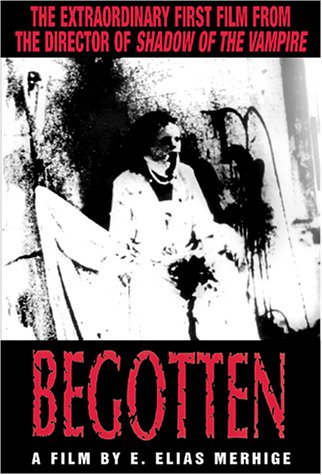 A profoundly repellant yet strangely lyrical and poetic cinemutation, BEGOTTEN is a wordless black and white reverie in which God kills himself and begets Mother Earth, who in turn begets Mankind, who in turn endures all manner of abuse. Yes, that’s the premise (more or less) of this amazing creation, as unique and unprecedented, in its way, as David Lynch’s seminal ERASERHEAD.
A profoundly repellant yet strangely lyrical and poetic cinemutation, BEGOTTEN is a wordless black and white reverie in which God kills himself and begets Mother Earth, who in turn begets Mankind, who in turn endures all manner of abuse. Yes, that’s the premise (more or less) of this amazing creation, as unique and unprecedented, in its way, as David Lynch’s seminal ERASERHEAD.
Filmmaker E. Elias Merhige is best known as the director of 2000’s vastly overrated SHADOW OF THE VAMPIRE and ‘04’s dreary SUSPECT ZERO, as well as Marilyn Manson’s notorious “Anti-Christ Superstar” music video. Merhige’s premiere feature BEGOTTEN appeared in 1989 and dwarfs all his subsequent film work; for that matter, it eclipses most other “experimental” features then and now.
BEGOTTEN came out of the director’s years at the State University of New York at Purchase, where Merhige formed the Theatreofmaterial (patterned, apparently, after the Viennese “Materialactionfilms” of Otto Muhl and Kurt Kren), whose members assisted in the creation of BEGOTTEN. In conceiving the film Merhige claims: “I used those parts that scared me, or that I just couldn’t understand—the parts that stuck with me for days and that forced me to wonder where within me did this come from?” The film was shot in various New York state locations and then subjected to a torturous post-production process in which Merhige utilized a specially designed optical printer to create a uniquely grainy, bleached-out look.
Unsurprisingly, BEGOTTEN didn’t exactly set the box office on fire. Initial screenings were confined to colleges and museums, but interest in the film steadily mounted and it was eventually released on VHS in 1995 and DVD in 2001. Both are now out of print, unfortunately, but interested parties are urged to track down a copy ASAP!
Since BEGOTTEN has nothing remotely resembling a traditional “story”, any attempt at explaining its wildly elliptical, symbolic narrative is automatically doomed to failure. Nevertheless, I’ll give it a try.
In a secluded cabin in the midst of a forest, God, wearing a long white lab coat and scraggly haired wig, relentlessly mutilates himself with a straight razor (we know this because the end credits identify the figure as “God Killing Himself”). Once the orgy of hacking, bleeding, vomiting and shitting is finished a young woman in a Mardi gras eye mask emerges from under God’s cloak. This is Mother Earth, who frees God’s penis—which evidently still works despite the fact that its user has died—and impregnates herself with it.
Next we see Mother Earth wandering through a nightmarish primordial landscape with a naked young man identified in the credits as “Son of Earth—Flesh on Bone”, who appears to be undergoing a perpetual epileptic seizure. He vomits up several large pustules which are eagerly collected by a nomadic tribe who happen to be in the area; in exchange, the tribe helps Mother Earth and her charge by attaching ropes to Son of Earth and dragging him over a cliff (he being apparently unable to walk).
A bit later Mother Earth is set upon by another tribe, this one a band of savages who rape and disembowel her. This attracts several basket-headed farmers, who gather up Mother Earth’s remains and take them to a farm-like enclosure. Thus Son of Earth has to crawl through the world by himself, at least until the basket-heads track him down and beat him to death. A vast rainstorm follows, after which the farmers use the organs of Mother Earth and her offspring to fertilize the barren ground.
What immediately impresses the viewer about BEGOTTEN is its look: an elemental black and white dreamscape. Sometimes the images have an artificial sheen akin to animation and at others are speckled with visible grain that pulses and strobes. This, combined with the total lack of dialogue, subtitles or narration, means it’s often difficult to make out what’s happening, which only enhances the film’s otherworldly allure. Particularly noteworthy is the stunning opening, with God killing Himself amidst a torrent of spurting blood and erupting viscera. At once deeply off-putting and hypnotically beautiful, it is arguably the film’s finest sequence and certainly a benchmark in the realm of cinematic grotesquerie.
Much of the remainder of BEGOTTEN was apparently shot on and around construction sights, yet, as seen through Merhige’s chiaroscuro images, the landscapes have a genuinely mythic, almost prehistoric feel (marred only by visible tire tracks in one scene). Other notables include slow and fast motion, some truly odd camera angles and enough gore to fill a dozen FRIDAY THE THRITEENTH movies. Not every viewer will appreciate E. Elias Merhige’s Stan Brakhage-meets-Lucio Fulci aesthetic; BEGOTTEN is deeply uncompromising not only in its extreme violence but also in its torturously slow pace and often agonizingly uneventful narrative. It’s a measure of Merhige’s accomplishment that I was never once tempted to abandon the film, even at its most tedious and/or gruesome moments.
Vital Statistics
BEGOTTEN
Complex Corporation/Theatreofmaterial
Director/Producer/Screenwriter/Cinematographer/Editor: Edmund Elias Merhige
Cast: Brian Salzburg, Donna Dempsey, Stephen Charles Barry, James Gandia, Arthur Streeter, Michael Phillips, Erik Slavin, Garfield White, Daniel Harkins, Adolpho Vargas, Terry Anderse
